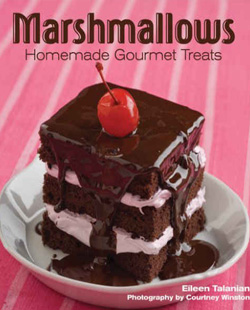 We are all stamped by our youth. It’s often said that if you don’t learn a second language by age twelve, it’s hopeless. Ask me to conjugate a French verb, and I’ll prove that idea.
We are all stamped by our youth. It’s often said that if you don’t learn a second language by age twelve, it’s hopeless. Ask me to conjugate a French verb, and I’ll prove that idea.
The foods of our youth, the foods we saw as we followed Mom down the supermarket aisles, often serve as our emotional standards. Mustard? I think of French’s, pure and yellow. Bread? I did not grow up on New York rye. Sadly, it’s Wonder Bread. Carmels? Kraft, of course, and you all know they are world-class good. Marshmallows? Oh, Kraft again. I remember you could buy a bag, stash it away, and come back a year later to something that still seemed pretty decent. A bit dry, but, hey, it’s the way marshmallows are, right?
A few years ago, fresh marshmallows began to appear in Manhattan bakeries. City Bakery, for example, offers a single stack of vanilla luxury. Smooth, fresh, and rich. They aren’t cheap but what good decadence ever is?
I’ve wanted to make my own, of course, but I just had the assumption that it would be hard. There would be egg whites and complicated cooking and possibly a mess. And then, a month ago, I was walking by the cookbooks at B&N when my eye caught Marshmallows: Homemade Gourmet Treats by Eileen Talanian. I kind of remember the book actually speaking to me, “Buy me. You can do it.”
I scanned the book, saw one recipe after another that I simply had to try, and I bought it. The next weekend, at our upstate kitchen, I set out all the ingredients for classic vanilla marshmallows. And, no, there are no egg whites. Suzen walked into the kitchen and looked at the gelatin, vanilla, and sugar set out on the tabletop and warily asked, “What is this?”
I did not answer her. I simply open up Marshmallows and put the Vanilla Marshmallows recipe about twelve inches from her nose. It took a few seconds for her to understand and then … I have to say I haven’t seen her move faster in the kitchen in years.
The marshmallow recipes in this book are fantastic. The flavors, textures, and aromas simply overwhelm your senses. Homemade fresh means just that. Making them is not a spur of the moment thing. Immediate gratification is not possible here.
First you make a very dense sugar syrup, cooking to exactly 240° which means you need a very good candy thermometer. Then a gelatin mixture is prepared, some cooled sugar syrup is added, and this mixture is heated to 250°. This very hot mixture goes into the bowl of an electric mixer and is whisked for 10-12 minutes. The hot liquid is transformed before your eyes into a flowing, yummy, immaculately white ambrosia. It’s a little magical. This warm creature goes into a 13”X9” pan to cool for at least four hours. [I said no instant gratification, but your mixer by now will be filthy with warm goop, enough to satisfy any of you]. After four hours, you cut the cooled marshmallows and — this is the really good part — roll each one in a flavored coating: the basic coating is powdered sugar and corn starch but Eileen offers many variations.
I know this sounds like work, which it is. I cannot convince you how wonderful your results will be. I can only encourage you to try, and then smile.
Marshmallows presents very clear, perfectly detailed recipes and walks you through each step. Rather than try to put all that detail her, let me encourage you to take your own gander at the book. Better yet, take a gamble, buy it, try it, and make your life just a little softer and tastier.
If you want an immediate peek at some great marshmallow ideas, try Eileen’s website: homemadegourmetmarshmallows.com

Hey, Brian,
THANKS for the great write-up! Enjoy the marshmallows and be sure to try some of your own variations.
et
This post was very well written, and it also contains a lot of useful facts. I enjoyed your distinguished manner of writing this post. Thanks, you have made it easy for me to understand.